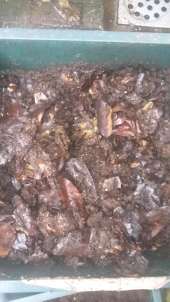My goal was to reduce the volume of waste we send to the landfill, to reduce nutrient loss from our property, and to create my own soil amendment for gardening.
The challenges in my area are keeping the bins moist enough (year round) and warm enough (in the winter= zone 5). I have two bins that are each about a cubic yard in size. I made them big so there would likely always be a warm, wet spot in the middle for them to migrate to if needed. The bins are made out of cedar fence wood with small (quarter-inch) gaps for air. If I had to it all over again, I would have made the gaps smaller, as I am still losing too much moisture.
In the winter, I have 3 feet of dry leaves above the worms, inside the bin, to provide insulation. I harvest the compost twice a year to minimize the disturbance to the worms, once in the spring and once in the fall. I feed them about 25 gallons of food scraps per week, plus all the trimmings and leaves from the yard. I would estimate about one-fifth of the food scraps are citrus.
I ferment the food waste for one week before putting in, and this seems to help a lot with the smell. I also cover each deposit with a thick layer of shredded leaves to cut back on fruit flies. Having a solid floor is a good idea, as roots from neighboring plants aggressively invade the bins.
I use a DIY, mechanical, rotary, two-stage screener to sift the castings to retain the worms and eggs. I spend about a half-hour a week adding material, and about 30 hours a year harvesting and sifting. I end up with about 3 cubic yards of finished product per year. Never quite sure how big my herd is, but I do know they are hard-workers.











